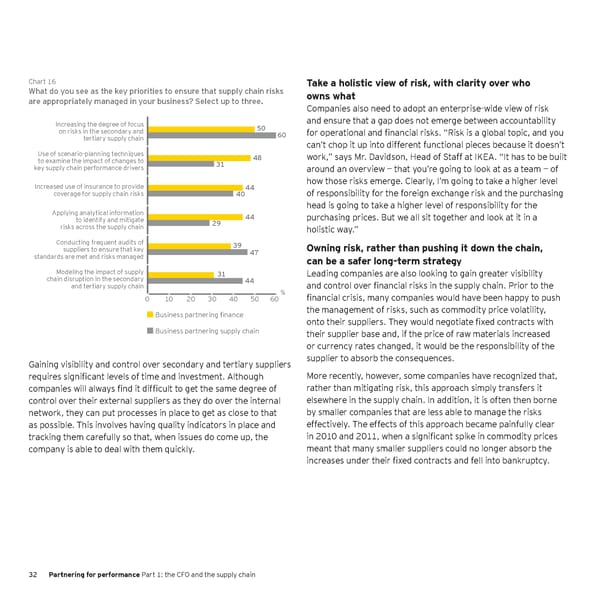Chart 16 Take a holistic view of risk, with clarity over who What do you see as the key priorities to ensure that supply chain What do you see as the key priorities to ensure that supply chain risks risks are appropriately managed in your business? owns what are appropriately managed in your business? Select up to three. Companies also need to adopt an enterprise-wide view of risk Increasing the degree of focus and ensure that a gap does not emerge between accountability on risks in the secondary and 50 for operational and financial risks. “Risk is a global topic, and you tertiary supply chain 60 can’t chop it up into different functional pieces because it doesn’t Use of scenario-planning techniques 48 work,” says Mr. Davidson, Head of Staff at IKEA. “It has to be built to examine the impact of changes to 31 key supply chain performance drivers around an overview — that you’re going to look at as a team — of Increased use of insurance to provide how those risks emerge . Clearly, I’m going to take a higher level 44 coverage for supply chain risks 40 of responsibility for the foreign exchange risk and the purchasing head is going to take a higher level of responsibility for the Applying analytical information 44 purchasing prices . But we all sit together and look at it in a to identify and mitigate 29 risks across the supply chain holistic way .” Conducting frequent audits of 39 Owning risk, rather than pushing it down the chain, suppliers to ensure that key 47 standards are met and risks managed can be a safer long-term strategy Modeling the impact of supply 31 Leading companies are also looking to gain greater visibility chain disruption in the secondary 44 and tertiary supply chain and control over financial risks in the supply chain. Prior to the % financial crisis, many companies would have been happy to push 0 10 20 30 40 50 60 Business partnering finance the management of risks, such as commodity price volatility, onto their suppliers. They would negotiate fixed contracts with Business partnering supply chain their supplier base and, if the price of raw materials increased or currency rates changed, it would be the responsibility of the Gaining visibility and control over secondary and tertiary suppliers supplier to absorb the consequences . requires significant levels of time and investment. Although More recently, however, some companies have recognized that, companies will always find it difficult to get the same degree of rather than mitigating risk, this approach simply transfers it control over their external suppliers as they do over the internal elsewhere in the supply chain . In addition, it is often then borne network, they can put processes in place to get as close to that by smaller companies that are less able to manage the risks as possible . This involves having quality indicators in place and effectively . The effects of this approach became painfully clear tracking them carefully so that, when issues do come up, the in 2010 and 2011, when a significant spike in commodity prices company is able to deal with them quickly . meant that many smaller suppliers could no longer absorb the increases under their fixed contracts and fell into bankruptcy. 32 Partnering for performance Part 1: the CFO and the supply chain
 Partnering for Performance Part 1 Page 33 Page 35
Partnering for Performance Part 1 Page 33 Page 35